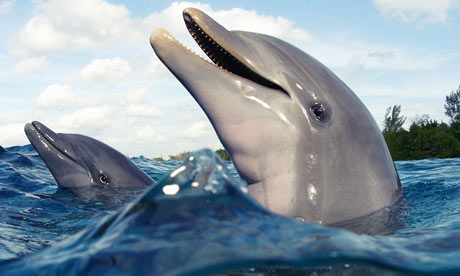Wikipedia-style website to record every species on Earth
Coming soon to a screen near you: The Encyclopedia of Life – a user-generated database of all living things

Bottlenose dolphins (Tursiops truncatus) will have their own webpage. Photograph: Getty Images
A complete list of all the species on the planet is, for many biologists and conservationists, the natural history equivalent of the Holy Grail. So the recently-launched EoL (it stands for ‘Encyclopedia of Life’), which aims to create not just a list, but an individual web-page, for every single one of the world’s plant and animal species, is bound to cause a buzz.
Make no mistake, this will be a truly Herculean task. There may only be about 5,000 species of mammals, 8,000 species of reptiles, and 10,000 or so species of birds. But once we get to groups like flowering plants (about 250,000 species, and that’s not including hybrids), insects (over 1m species described, with perhaps another 5m new ones waiting to be discovered), let alone micro-organisms such as viruses and bacteria, it’s easy to see why EoL might seem little optimistic.
So how does EoL work? Well, like its forerunner Wikipedia, EoL is a self-perpetuating encyclopedia, written by and refereed by anyone who wants to contribute. In practice, the contributors are likely to be mainly professional scientists or talented amateur naturalists – in some cases the leading experts on a species or group. Others can add text, images and even video clips to each entry, with the ultimate goal of making information about all the world’s organisms freely available.
Accuracy will be ensured (hopefully, at least) by an expert team of curators, who will weed out any inaccuracies and clarify any confusions. Like Wikipedia, there will be no charge for anyone wishing to access the information, so writers must be willing to share their knowledge with anyone else under a ‘creative commons licence‘. Original sources will also be credited where possible.
So far, so good. But anyone familiar with recent controversies in biological science – and in particular taxonomy, classification and nomenclature – will immediately be aware of problems beyond the sheer workload involved. Broadly, these break down into three areas of potential confusion:
• What is a species? Although we know that the African elephant and Indian elephant are different species, and likewise the house sparrow is a different species from the tree sparrow, many divisions between species are not so clear-cut. Scientists may lump two previously separate species together (like the Bullock’s and Baltimore orioles of the US), or split one apart (as in bean and pink-footed geese). And when it comes to the differences between closely related plants and their many hybrids, things can get really confusing.
• What is its name? Brits call divers “divers”, Americans call them loons; likewise “skua” (UK) and “jaeger” (US). In Africa things get even more confusing, while many species of insect and plant don’t have an English name at all. And what about the non English-speaking world? OK, we could use scientific names, but even these change, as has recently happened with the classification of such common and widespread species as the tits.
• How many species are there? I’ve already touched on this – but when you realise that the 2m species currently identified represent as little as 2% of all the species on Earth, it’s easy to see why EoL may turn out to be a bit like painting the Forth Bridge – just when you think it’s finished, up pops some other obscure organism begging for entry to the club.
Despite these caveats, though, I think the founders of EoL do deserve praise and support. And as one representative of our own species, the poet Robert Browning, wrote:
Ah, but a man’s reach should exceed his grasp,
Or what’s a heaven for?
